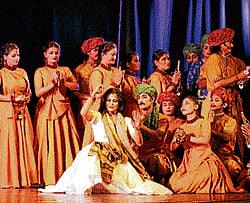Continuing its ‘Summer Ballet Festival 2012,’ the premiere art and culture institution of India- Shriram Bharatiya Kala Kendra presented a dance-drama ‘Meera’ at the Kamani auditorium recently.

As the name indicates, the ballet was based on the life of the legendary saint-poetess of Rajasthan- Meera, her life, devotion and sacrifice. In an artistically rich presentation of Meera’s travails, witnessed by a crowd of nothing less than 300 enthusiastic viewers, the programme spell-bound all present.
The ballet opened with the birth of Meera- the Rajput princess, who is brought up with royal care and affection. Played by actor Suchita Das Tithi, she is welcomed onto the stage by female dancers as royal attendees with a beautifully choreographed dance to the tune of folk song jhoola dheere jhula ri. The resplendence of the desert kingdom is shown exquisitely with a set designed as a high fort, colourful Rajasthani costumes, befitting music and perfectly synchronised lights. Even the make-up of each dancer complimented the whole Rajasthani setting.
Then in a decisive turn of events, a convoy of Krishna devotees appear below the stage singing bhajans and Meera is visible fascinated. She welcomes the convoy to rest at her palace and tends to them with due reverence.
Before leaving, the chief devotee presents Meera with an idol of Krishna and she becomes extremely attached to it. The idol, depicted by a piece of cloth only, stays a permanent fixture on the stage even as characters and actors keep changing during the ballet.
Even as Meera’s fondness for the idol keeps growing, her parents get worried and arrange for her marriage with prince Bhoj Raj. Emotional scenes are played out here as an inconsolable Meera portrays her unwillingness for this alliance, through dance, but has to agree to her father’s wish at the end. Then in a scene depicting sorrow and transition, Meera- the devotee of Krishna separates herself from the to-be-bride of Bhoj Raj, and marries the prince. From here onwards, Meera is played by actor Radhica Laukaran.
From here starts the torment of Meera when her mother-in-law realises that she is unwilling to pray to the family deity - Tulaja Bhawani. In time, prince Bhoj Raj is killed in a battle and his father Rana Sanga of Chittor tries to get rid of Meera in several ways. First he sends poison for her, fixes iron nails on her bed and then sends a snake for her in a flower basket, but Meera survives each attempt.
The last scene is depicted beautifully with dancers carrying long black ropes, symbolising snakes, trying to capture Meera, but after an initial struggle she breaks free of all of them.
After these ordeals Meera finally leaves the palace, and her mortal life of miseries, for a living of spiritual abandon. The ballet ends with the two Meeras coming together and uniting into the eternal lover Lord Krishna. Joyous songs reverberate in the auditorium as the forgiving saint Meera blesses mankind.
The director of ‘Meera,’ and all the ballets in ‘Summer Ballet Festival,’ Shobha Deepak Singh recounted, “In the beginning, Meera seemed to pose no creative challenge. But by the end of the research that Shubha Mudgal - who provided music, Keshav Kothari- sets expert, Shashidharan Nair- the choreographer and myself had done, we were convinced that it would make an exceptional ballet. All of us worked very hard on this new interpretation and so we hope, Meera, lives on.
